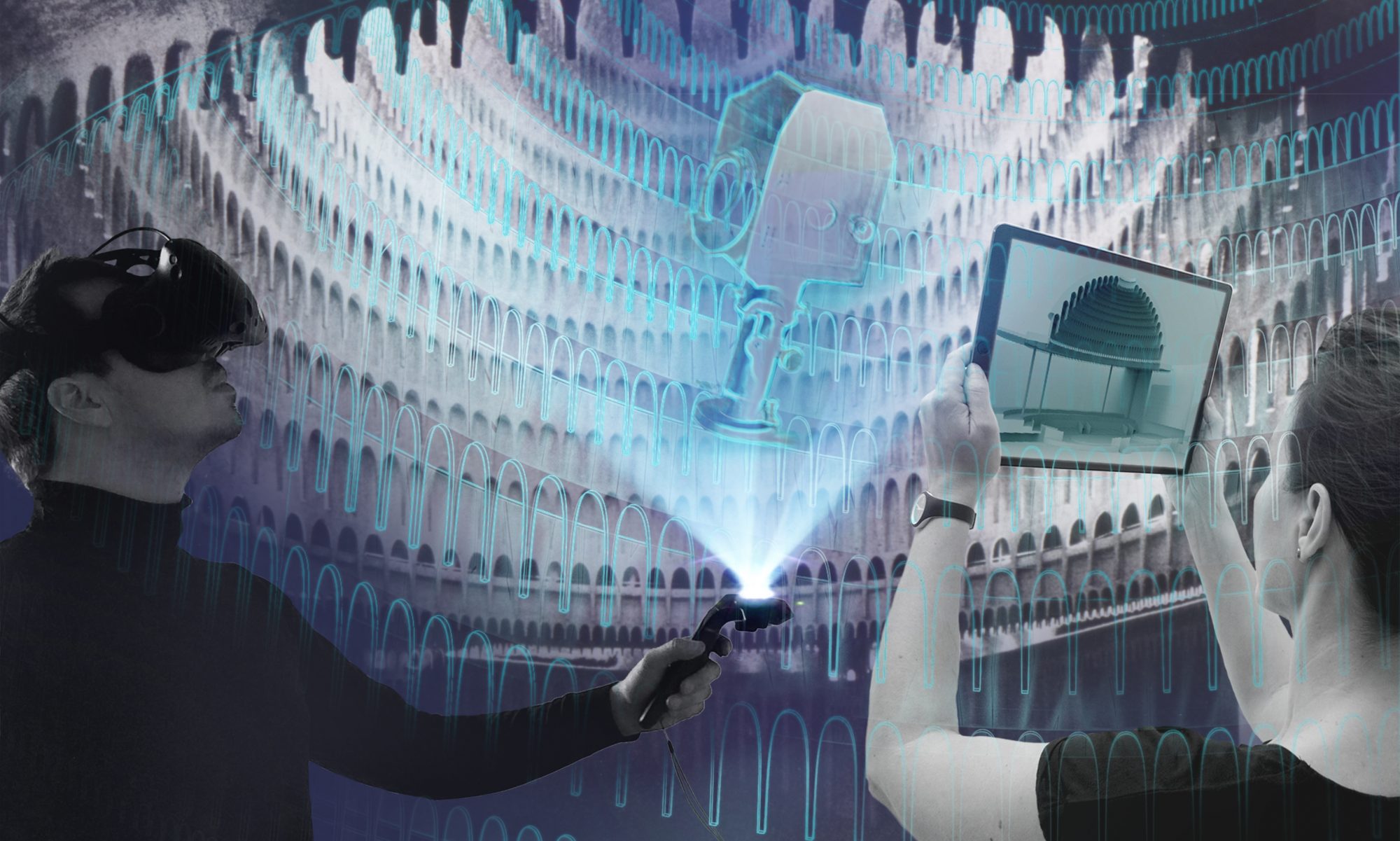What is the relationship between theater and immersive technologies? What spatial, technical and narrative qualities does a medium like virtual reality offer? Which aspects are important?
The origins of virtual worlds, pictorial spaces, and space-based storytelling lie in the human need to make stories a sensory experience. This motivation is also the basis for the close relationship between virtual reality and theater: as world builders, both theater creators and VR developers enable their audiences to visit foreign places or travel back in time to the future and the past – this is where the sense of reality meets the sense of possibility. Both are spatially immersive media and work with similar methods such as suspending physical laws, playing with social conventions; both deal with questions of participation and give possibilities of changing perspectives. Theater and virtual reality are open play spaces and laboratories for thought experiments.
The perspective is shaped by our artistic-technical engagement with virtual reality and theater – in their role as imaginative spaces, as places for shared experience, reflection and learning, as possibilities for art experience and reflexive self-awareness. In our research project Im/material Theatre Spaces, we have explored the potentials of immersive technologies in their interplay with theater and its spatial, technical, and narrative qualities. In several blog posts we relate two virtual reality experiences from this research project and consider them in the context of other projects from the fields of museum, game design, film and theater.

The VR experience Opening Night at the Große Schauspielhaus – Virtual Reality Time Travel Berlin 1927 aims to do justice to theater as an immaterial art form in its entirety as well as to impart knowledge of theater history. The focus here is on the reconstruction of the no longer existing Großes Schauspielhaus Berlin – one of the theater architectural icons of the 20th century. The cultural mediation of theater, its history and heritage is per se a challenging task, because its peculiarity as an ephemeral art form and its complexity as a total work of art are difficult to reproduce retrospectively. There is much more to the intangible cultural heritage of theater than what is presented on stage: the stories and the diversity of its participants, the interplay of artistic and technical forces, and the special atmosphere of the theater. We meet this challenge with the help of virtual technology and narrative methods: In the VR experience, three protagonists invite us on their personal journey of memory through the Großes Schauspielhaus and provide us with a multi-voiced image. This raises questions about different spatial narratives and their modes of action: What dramaturgical and scenographic means do we use to create virtual spaces of experience? How can a space be virtually set in motion? And how do visitors immerse themselves in such a moving space? Another aspect we want to illuminate here is the question of activating the audience: How much influence do we allow the users and how much interaction is possible, how much is necessary? How do we turn passive viewers into active doers?

In contrast to Opening Night at the Große Schauspielhaus, our second VR project Spatial Encounters is characterized by a different approach: While in the Schauspielhaus the recipients take on a rather consuming attitude, the artistic work in Spatial Encounters only emerges through the co-creative interaction and spatial relationships of several acting persons. Audience, musicians and media artists together create a hybrid-real spatial situation – live and always new. What are the characteristics of a hybrid-real “in-between world” as a transitional space? What conditions are necessary for the success of cocreation, immersion and co-presence in hybrid-real space? And what spatial effects can be developed in hybrid parallel worlds?
The projects and topics presented in the blog articles can also be viewed from a reciprocal perspective: While in the Virtual Große Schauspielhaus the complexity of the spatial-social theater structure is made tangible through the individual but multi-perspective narrative strands, in Spatial Encounters dialogically negotiated, spontaneous narrative strands emerge between the emancipated Akteur:innen – without programmatic specification. Here, the quality of the experience is determined by the communicative interaction of the group. This makes clear how a free scope of action can only unfold its full co-creative potential through a dramaturgical framework.
While in the Großes Schauspielhaus we are immersed in an ultimately static pictorial space of a (reconstructed) architecture and are moved through the building with the story, in Spatial Encounters the space is only constructed by the movement of the visitors and is constituted at least for the moment of experience. In its fleetingness lies its quality, which leads to a high level of identification with the project.
If we look at the Virtual Große Schauspielhaus under the aspect of hybrid realities, it becomes clear that the immersion in virtual space is in the foreground. The physical space and its scenographic design also play a decisive role: the intended installation site is the foyer of the Friedrichstadt-Palast Berlin, where an exhibition contextualizes and expands the content of the experience for the visitors. Selected exhibits can be found both analog and as digital twins in the virtual world. The spatial staging of the VR station in the form of an abstracted artist’s dressing room sets the mood for the theme and also provides a safe shelter. The interweaving of the virtual space with its material anchoring in the physical means that the intended immersion can succeed at all and that the viewers can engage with the experience.
This highly complex interplay between new types of narrative, methods of participation and the creation of im/material spaces of experience – VR and theater are in no way inferior in this respect – opens up far-reaching possibilities for artistic expression. In this field of tension, space – especially as stage space – can be explored in its physical and virtual qualities.
Authors: Franziska Ritter and Pablo Dornhege


